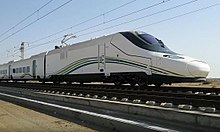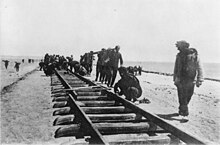
Transport in Saudi Arabia is facilitated through a relatively young system of roads, railways and seaways. Most of the network started construction after the discovery of oil in the Eastern Province in 1952, with the notable exception of Highway 40, which was built to connect the capital Riyadh to the economically productive Eastern Province, and later to the Islamic holy city of Mecca and the port city of Jeddah. With the economic growth of the 1970s, the Kingdom of Saudi Arabia has initiated many infrastructure development projects across the country, and the extensive development of the transportation network has followed suit in support of various economic developments.

Al-Jawf Province, also spelled Al-Jouf, is one of the provinces of Saudi Arabia, located in the north of the country, partially bordered by Jordan to the west. It is one of the earliest inhabited regions of Arabian Peninsula, with evidence of human habitation dating back to the Stone Age and the Acheulean tool culture. Human settlement continued unbroken throughout the Copper Age, a period that saw the kingdom of Qidar fight against the Assyrian state for its independence. It is also in this period that references to Arabs first appear in historical texts. A Christian kingdom later emerged under the rule of the Bani Kalb tribe and survived until the arrival of Islam and the Islamic conquest of Al-Jawf. Following the region's Islamization it fell under the control of the Tayy tribe. Al-Jawf was incorporated into the third Saudi state at the time of its formation in 1932. In the 20th century the region was a site of conflict between the Al-Rashid family and the Al-Shaalan family, though it eventually came under the rule of King Abdulaziz bin Abdul Rahman Al Saud.
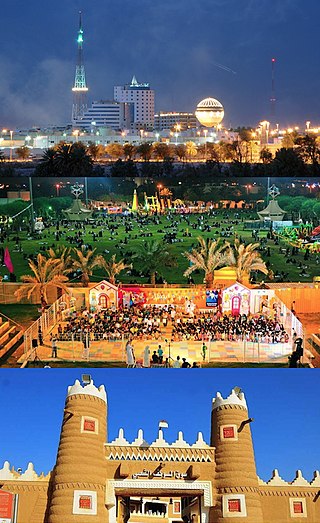
The Qassim Province, also known as the Qassim Region, is one of the 13 provinces of Saudi Arabia. Located at the heart of the country near the geographic center of the Arabian Peninsula, it has a population of 1,336,179 and an area of 58,046 km². It is known to be the "alimental basket" of the country, for its agricultural assets.

Dammam is the capital of the Eastern Province of Saudi Arabia and the kingdom's fourth-most populous city, with a total population of 1,532,300 as of 2022. The judicial and administrative bodies of the province, in addition to the administrative offices of other minor governmental departments functioning within the province, are located in the city. The word itself is generally used to refer to the city, but may also refer to its eponymous governorate.
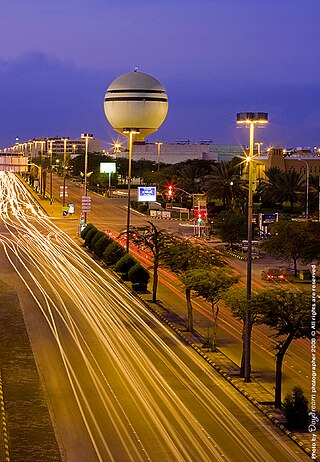
Buraidah is the capital and largest city of Al-Qassim Region in north-central Saudi Arabia in the heart of the Arabian Peninsula. Buraydah lies equidistant from the Red Sea to the west and Persian Gulf to the east. It is known for its dates festival which is the biggest in the world with extensive variety of dates. It has been called the city of dates. On November 8, 2021, the United Nations Educational, Scientific and Cultural Organization "UNESCO" included the city of Buraidah among the UNESCO Network of Creative Cities, in the field of gastronomy. The location is possibly first described in the Book of Genesis: "Therefore the well was called Beer Lahai Roi. Behold, it is between Kadesh and Bered."

The Saudi Railways Organization (SRO) was a state-owned railway company that operated part of Saudi Arabia's rail network, along with the Saudi Railway Company. The SRO operated a network of railways with a total length of approximately 1,380 kilometers. The network consisted of two main lines. A 449 km passenger line that links Dammam with Riyadh, and a 556 km freight line that connects the King Abdul Aziz Port in Dammam with Riyadh.

Jeddah Islamic Port is a Saudi Arabian port, located in Jeddah on the Red Sea, at the middle of an international shipping route between the east and west via the Suez Canal. It is the second-largest and second-busiest port in the Arab world. The city of Jeddah is the second-largest city in Saudi Arabia, and is Saudi Arabia's commercial capital.

Articles related to Saudi Arabia include:

The Saudi Landbridge is a railway line currently under development by the Saudi Railway Company (SAR).

The Dammam–Riyadh line is a passenger railway line in Saudi Arabia, linking the Eastern Province's capital city of Dammam with the Saudi capital Riyadh. The 449 km (279 mi) line has four stations. It is owned and operated by Saudi Arabia Railways.
Ras Al-Khair is a town and port currently under development in the Eastern Province of Saudi Arabia. It is on the eastern coast, 60 km north of Jubail. It is also known under its project name of "Minerals Industrial City".

The SAR North–South Railway line is a 2,750 km network of railway lines in central and eastern Saudi Arabia, built and operated by the Saudi Railway Company. The primary line of the network connects the capital of the kingdom, Riyadh, to the border with Jordan at Al Hadithah.
The Dammam metropolitan area, or Greater Dammam, is the largest metropolitan area in the Eastern Province of Saudi Arabia. It consists of "The Triplet Cities" of Dammam, Khobar, Dhahran, Qatif and their vicinities. It had a population of 2,190,900 as of the 2022 census. It is known for the arts, pearl culturing, entertainment and popular music and sports legacies. The area includes a variety of natural landscapes, parks, and beaches with a recreational coastline to the Persian Gulf. The Greater Dammam area is also known for being one of the cornerstones of the oil industry with the world's largest oil company and most valuable company, Saudi Aramco, being based in Dhahran, as a result of the first oil well being dug in the area.

Highway 65 is a major north–south controlled-access highway in central Saudi Arabia, spanning 1,427 km (887 mi). Popularly known as the Riyadh–Qassim Expressway, Highway 65 connects Howtat Bani Tamim to Qurayyat and further to the Al Hadithah border with Jordan, while providing connections to or passing through Riyadh, Majma'ah, al-Ghat, Zulfi, Buraidah, 'Unaizah, ar-Rass, Ha'il, Daumat al-Jandal, Sakakah and other smaller villages and towns. It also provides access to the Naisiyah Wildlife Reserve, Khanafah Wildlife Sanctuary, Tubaiq Natural Reserve, and the Harrat al-Harrah Conservation.

Highway 40 is a major east–west six-lane controlled-access highway in Saudi Arabia, spanning 1,395 km. The highway connects Jeddah, the second-largest city in the kingdom, on the western coast of Saudi Arabia to Dammam, the sixth-largest city on the eastern coast and the largest in the Eastern Province. Apart from Jeddah and Dammam, Highway 40 also runs near or through Mecca, Ta'if, Riyadh, Abqaiq and Khobar along its length, and provides access to the Mahazat as-Sayd and Saja and Umm Al Ramth wildlife sanctuaries.

Saudi Arabia Railways, formerly the Saudi Railway Company, is the national railway company of Saudi Arabia. It is de facto a state-owned enterprise, as it is owned by the Public Investment Fund.
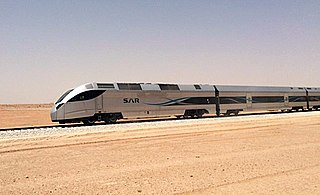
The Riyadh–Qurayyat line is a railway line in Saudi Arabia that connects the cities of Riyadh and Qurayyat. The 1,242 km line begins at Al-Qurrayat and passes through Al-Jouf, Hail and Al-Qassim regions before terminating in Riyadh. The line shares infrastructure with the SAR North–South Railway line between Buraidah and Al Nafud.

Dammam Station is the railway station serving the city of Dammam. It is the eastern terminus of the Dammam–Riyadh Line and one of the three railway stations with active passenger transport in the Eastern Province. The station also serves as the station of operations for the Saudi Railway Company (SAR).
